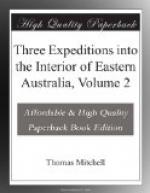Lastly a new Leucopogon, besides that found on the summit as already mentioned.*
(Footnote. L. rufus, Lindley manuscripts; ramulis foliis que subtus pubescentibus, foliis ovatis acuminatis apice spinosis erectis concavis supra laevigatis subtus striatis margine laevibus, floribus subsolitariis sessilibus axillaribus, barba corollae cinnamomea.)
ON THE APPLICATION OF NAMES.
In adding this noble range of mountains to my map I felt some difficulty in deciding on a name. To give appellations that may become current in the mouths of future generations has often been a perplexing subject with me, whether they have been required to distinguish new counties, towns, or villages, or such great natural features of the earth as mountains and rivers. I have always gladly adopted aboriginal names and, in the absence of these, I have endeavoured to find some good reason for the application of others, considering descriptive names the best, such being in general the character of those used by the natives of this and other countries. Names of individuals seem eligible enough when at all connected with the history of the discovery or that of the nation by whom it was made. The capes on the coast I was then approaching were chiefly distinguished with the names of naval heroes and, as such capes were but subordinate points of the primitive range, I ventured to connect this summit with the name of the sovereign in whose reign the extensive, valuable, and interesting region below was first explored; and I confess it was not without some pride as a Briton that I more majorum* gave the name of the Grampians to these extreme summits of the southern hemisphere.
(Footnote. Procedo, et parvam Trojam, simulataque magnis Pergama, et arentem Xanthi cognomine rivum, Agnosco. Aen. lib 3.)
REPOSE IN THE VALLEY.
We reached the banks of the little river where the horses awaited us in three hours, the distance being eight miles from the summit of Mount William. There we found a large fire and, under a wide spreading casuarina during a delightful interval of about twenty minutes, I enjoyed the pleasures of eating, sleeping, resting, and warming myself, almost all at the same time. To all who would know how to enjoy most intensely a good fire, shelter, sunshine, and the dry soft turf I would recommend, by way of whet, a winter night on a lofty mountain, without fire, amidst frost-covered rocks and clouds of sleet. I shall long remember the pleasure of those moments of repose which I enjoyed on my arrival in the warm valley after such a night. We could afford no longer delay however, having brought provisions only for one day with us, whereas this was the morning of the third of our absence from the camp. Retracing our steps we reached the little river only at eight in the evening and, as I hoped to find a ford in it at daylight, we lay down on its bank for the night.
NIGHT’S REST.




